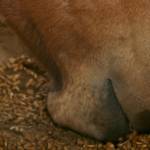Carbohydrates in Equine Nutrition

About 75% of all plant matter is comprised of carbohydrates. This fact means that carbohydrates are an extremely important part of a horse’s diet. There are a number of different types of carbohydrates in horse feed, and they vary considerably as to how well horses digest and utilize each one. In nutritional terms, carbohydrates can be divided into two broad categories: nonstructural carbohydrates (NSC) and structural carbohydrates (cell wall).
Nonstructural carbohydrates are those that either occur as simple sugars in the horse’s feed, or can be broken down by enzymes produced by the horse. Included in this category are glucose, fructose, lactose, sucrose, and starch. They range from being almost nonexistent in a grass hay diet to comprising a high percentage of the total diet in a high-grain, low-fiber ration.
Structural carbohydrates are those that are resistant to the horse’s digestive enzymes. These carbohydrates occur in the cell wall portion of the plant and must be fermented by bacteria living in the horse’s gut before they can be utilized by the horse. As a group, these carbohydrates are called plant fiber, and they consist primarily of cellulose and hemicellulose.
Carbohydrates got their name from the fact that they contain carbon combined with hydrogen and oxygen, usually in the same ratio as in water. The basic repeating unit of a carbohydrate is called a monosaccharide. These usually have either five carbons (pentoses) or six carbons (hexoses).
Hexoses are the most important types of carbohydrates for horses. Hexoses that appear naturally as single sugars (monosaccharides) are fairly rare. Glucose and fructose are the only ones that appear free in nature. When glucose appears as a single sugar, it is called dextrose. Small amounts of dextrose are found in fruits and fruit juices and also in honey. It is obtained commercially by the hydrolysis of cornstarch. Glucose is of special interest in horse nutrition because the digestion of many more complex carbohydrates yields glucose as the end product of digestion and it is the form of carbohydrate that circulates in the blood. Glucose has a sweet taste, but it is not as sweet as cane sugar.
Fructose occurs freely along with glucose in fruits and honey and in combined forms in higher carbohydrates. It is sweeter than sucrose, which is a two-sugar molecule (disaccharide) composed of one glucose and one fructose. Sucrose, the sugar obtained from sugar cane or sugar beets, is the type used on the table and in cooking. It also occurs in ripe fruits and in tree sap (maple syrup). On hydrolysis with the enzyme sucrase or dilute acids, sucrose is split into mixtures of glucose and
fructose, which are called invert sugars.
Cane molasses also contains sucrose, glucose, and fructose. After sugar cane juice is boiled down and as much sugar as possible has been crystallized from it, the remainder is known as cane molasses. It contains about 55% invert sugar. Lactose is another disaccharide composed of one glucose molecule and one molecule of galactose, another hexose monosaccharide. Lactose, the sugar in milk, is only about one-sixth as sweet as sucrose. It is broken down by the enzyme lactase and it is less likely than glucose or sucrose to undergo acid fermentation in the stomach, a process that may result in tissue irritation. It promotes the development of acidophilic organisms in the intestine and opposes the growth of undesirable putrefactive bacteria in foals. Lactose also has been shown to favor calcium and phosphorus assimilation, so it is the sugar of choice for the suckling foal. As horses age, their ability to digest lactose decreases, so large intakes of lactose in the adult horse may lead to diarrhea.
Polysaccharides are complex carbohydrates that are strings of simple sugars of varying lengths. They are of high molecular weight and are usually insoluble in water. Upon hydrolysis by enzymes and acids, they are broken down into various intermediate products and finally to their constituent monosaccharides. The most important form of polysaccharide for horses is starch. Starches are long strings of glucose molecules in both straight chains (amylose) and branched chain structures (amylopectin).
Since monosaccharides are the only form of carbohydrates that can be absorbed from the intestine, more complex carbohydrates must be broken down into simple sugars before they can be utilized by the horse. Starches are broken down into the disaccharide maltose (two glucoses) by the enzyme amylase. Maltose, sucrose, and lactose are split into their two monosaccharide units by the disaccharide enzymes maltase, sucrase, and lactase which are produced in the intestinal brush border. These disaccharides are completely digested in the small intestine of the healthy horse. This is not the case, however, for starch. The horse’s ability to produce amylase is limited. Therefore, a great deal of the starch in a horse’s diet may escape digestion in the small intestine.
Starch source, processing, amount of intake, source and timing of forage feeding, and individual differences between horses affect prececal starch digestibility in horses.








